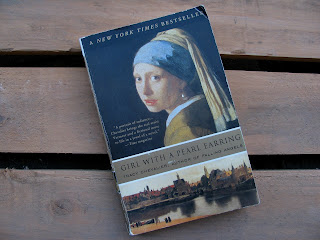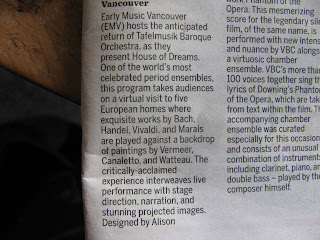I've read so many books on art theft and art forgery that someone might question my motives. But you can learn a lot about art and art history from this angle. I actually did a tiny forgery myself once. No, not "The Coffee X-Change".
My forgery was done about ten years ago as an assignment from one of my painting books. I had so much fun with it, I couldn't leave it behind when we moved to The Yellow House in 2012. The objective of the lesson called "A Colour Forgery" was to learn how to mix tube colours to get just the colour you want. The method: Cut out "colour chips" from magazines, glue them to a firm support in a design of your making, and then try to equate the magazine colours with your own paint mixes
Sound easy? It ain't. My final outcome is shown in the title image above -- the two panels (colour chips and painted "forgery") of my Matisse-inspired design. Some colour matches were fairly successful:
Others, less so:
When I unpacked these small panels recently, I considered continuing where I'd left off but decided to rest on my laurels, such as they were.
About this time a second-hand book and a friend's Facebook posting came my way, almost simultaneously. This was quite a coincidence because one doesn't have to go far into the field of art forgery, without thinking of Vermeer.
Of course, everyone knows Vermeer. He's an icon, for heaven's sake (to use that teeth-gritting word).
Because little is known about his 17th century life and because he made only 36 paintings, he and his work became the natural prey of the infamous art forger Hans Van Meegeren.
The story of Van Meegeren's trial is fascinating -- because he didn't exactly forge a painting -- he created new paintings that "forged" Vermeer's style.
But back to Vermeer.
One of the mysteries surrounding his work is whether or not his sublimely realistic paintings might have been created with the help of an optical device called a camera obscura.
-- or maybe even the simpler camera lucida. Personally, my eyes glaze over at these technicalities, but I'm intrigued by someone like Les Cookson, whose obsession is to hand-craft the beautiful boxes that are camera lucidas. (or is that cameras lucida?)
But Les Cookson's obsession is nothing compared to Tim Jenison's. The Jenison project was brought to my attention by my clever friend The Wizened Eye. Truly -- whether or not you've wended your way this far, through any of the previous links, you *have* to view this one -- it's otherwise indescribable.
http://boingboing.net/2014/06/10/vermeers-paintings-might-be.html
My friend The Wizened Eye not only has an eye for the exquisite in her own works. She also has a somewhat devious mind, and she pointed out that the Tim documentary was produced by the famous magicians Penn and Teller. The question that naturally follows -- Is the Tim thing itself a hoax? -- has been exhaustively addressed by another writer.
https://medium.com/@joshgans/10-reasons-to-doubt-tims-vermeer-c183bb3ce7a2#.puo83j1tc
The jury is still out on that one. But when you pull together the threads of art, money, and personality quirks, strange patterns can emerge.
And on show right now at Vancouver's Oakridge Mall (remember? Where art and high fashion meet) is a sale of twelve "3-D reproductions" of Van Gogh paintings, sanctioned by Vincent's great-great-great-nephew.
And there's an on-going real-life lawsuit around the Caravaggio painting sold by Sotheby's as a forgery, er, copy -- which has since been declared (by some) to be a real Caravaggio.
Ah, what a tangled web we weave, when first we practice to deceive...









